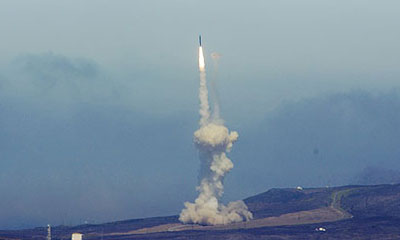Missile defense in 2006: now more controversial than everby Taylor Dinerman
|
| The Bush Administration went ahead with GMD instead of going with a space-based boost phase system that would have been easier to deploy and to test. |
These will have to be integrated with allied defense systems, including the Israeli Arrow/Patriot combination, Turkey, and any Arab states that agree—openly or otherwise—to support the US effort. Depending on the way the campaign is planned and which regional bases are made available, the US and its allies might find they need to defend nations in Eastern Europe or Central Asia. In the past the US Central Command and European commands have managed to work well together on missile defense issues, but this time the problems will be more complex and difficult than ever before. All aspects of such a campaign will test the Pentagon’s new network-centric systems to the limit.
Meanwhile the US Defense Department’s Missile Defense Agency is preparing for a number of tests while the operational side of the effort. The new Joint Functional Component Command - Integrated Missile Defense is beginning to take substantive shape. The 1st Brigade and the 100th Missile Defense Brigade, both of the Colorado Army National Guard, are forming up and moving towards full operational status, while at Fort Greely the 49th Missile Defense Battalion of the Alaska Army National Guard is doing the same. These units are said to have a rudimentary missile defense capacity in place now with ten or so interceptor missiles in the ground in Alaska and a couple in California. According to most experts this system is primitive indeed.
The principal weapons these units are supposed to control, the Ground Based Midcourse Defense Systems (GMD), has begun a new series of tests after the embarrassing ones that took place in 2004 and 2005. MDA hopes to launch a GMD from a silo at Vandenberg Air Force Base in California sometime in the spring. While other tests are planned during the course of the year, critics will make the reasonable claim that such demonstrations are unrealistic, but at an average price of $100 million dollars it is hard to see the MDA making them “realistic” any time soon.
Former Clinton Administration official Philip Coyle’s critique of MDA’s testing procedures, in an interview in the January 23rd edition of Space News, is interesting. It reminds us of the eternal truth of the late French president Pompidou’s wisdom when he said, “One should never put one’s enemy’s programs into effect. They will not thank you for doing so, since they are actually interested in power.” The GMD system was designed during the Clinton Administration to handle the single most difficult part of the missile defense problem: midcourse interception. The Bush Administration went ahead with this project instead of going with a space-based boost phase system that would have been easier to deploy and to test. To begin with, elaborate test ranges spanning a quarter of the Earth’s circumference would not be necessary.
Further in the interview Coyle claims that “Sea-based missile defense may have significant difficulty defending against anything not in the immediate area of the ships.” This may be accurate, if one takes a very generous view of what constitutes “immediate area”. The Navy has experience defending carrier battle groups that are normally dispersed over hundred of square kilometers. More testing will be needed to insure that the SM-3 can live up to its promise, but the fact that during the November 17, 2005 “emergency activation capability” test the Navy hit its target at more than 160 kilometers altitude and 600 kilometers from the launch site on the island of Kauai indicates that the system is showing some real potential to defend targets the size of greater Tel Aviv or metropolitan Tokyo.
| As with other projects, the desire of the Pentagon’s leaders to have something that will be even more capable than what was originally intended makes for both delay and extra expense. |
The MDA has changed the name of the THAAD from “Theater High Altitude Area Defense” to “Terminal High Altitude Area Defense”. This system that was once regarded as a system that would be deployed overseas to supplement Patriot batteries, is now seen as a potential lower-tier system that could be used to defend relatively small parts of the US homeland. After a long break testing was resumed in November of last year, and if all goes well the Defense Department hopes to have the first THAAD unit ready for fielding in 2009, ten years after the system’s first successful intercept.
As with other projects, the desire of the Pentagon’s leaders to have something that will be even more capable than what was originally intended makes for both delay and extra expense. If THAAD lives up to its potential then it will have been worth making the extra effort. This will probably not be apparent until the early years of the next decade. This may create a predictable yet fascinating political debate in Congress, with some politicians urging the Defense Department to deploy THAAD units in their district while others may not want any local defense at all.
The Iranian threat is going to dominate much of the national and international debate over the next year at least. So far little has been said about the potential for missile defense to blunt it, or to make it easier for the US launch an attack. If, as so many western statesmen say, it is unacceptable for a regime like Iran to have nuclear weapons, then doing something about it is going to involve more than just diplomacy. Negating Iran’s missile force will be a priority under any circumstance; the US will have to prove to itself and to its allies that it can accomplish this goal.
